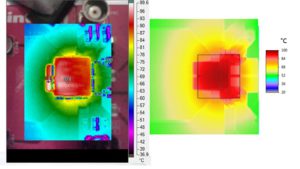There is more than power dissipation
The temperature of a component depends on its power dissipation (Watt), its foot- print area and the heat spreading capability of layer copper and FR4 in the PCB. Only in special academic setups it is possible to estimate the temperature from tables or with a pocket calculator. For better results you have to take into account the layout geometry using traces, planes and vias.
 You have to take into account some details
You have to take into account some details
Using TRM (Software "Thermal Risk Management") you can perform detailled 3-dimensional temperature calculations. The board model is assembled from Gerber files or self-made patches, drill files and assembled by graphical means or placement files. Many more features can be added with the user interface. The resolution in x-y direction typically is of the order of 0.1 mm to 0.2 mm. In addition to heated components electric trace heating (Joule heating) can be treated simulanously.
Component temperature influences function
Voltage drop can substantially depend on the local temperature of the trace (due to T-dependency of electric resistance) either by heating by current or by heating of nearby components. Many other component performance characteristics are also a function of component temperature.